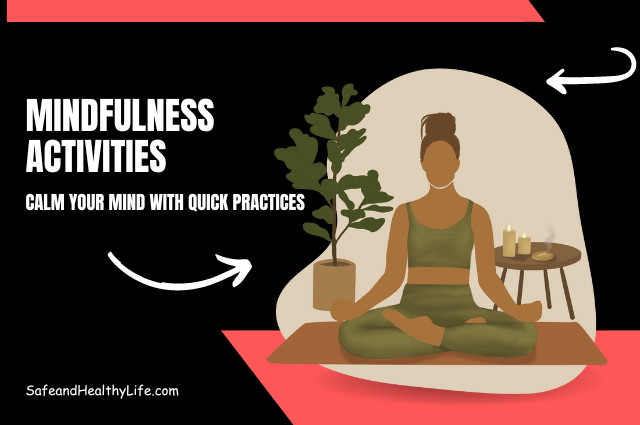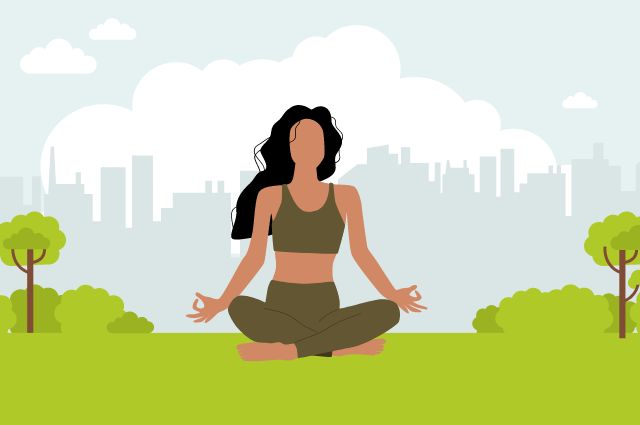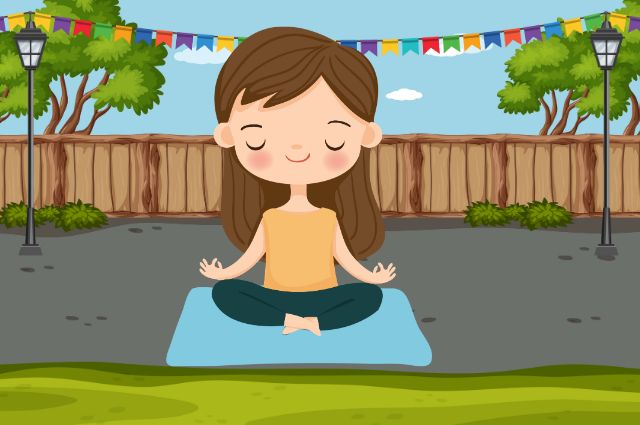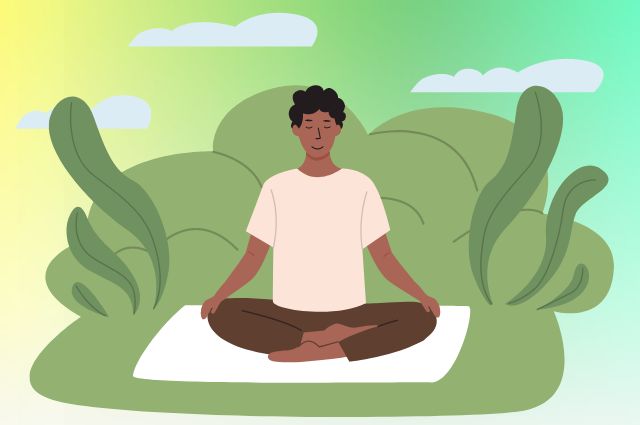
Mindfulness Activities, just three minutes a day could recalibrate your mind and redefine your day.
Imagine reducing stress, boosting productivity, and unearthing a newfound sense of calm. Curious?
You should be. These aren’t just esoteric practices – they’re science-backed techniques with cortisol-busting, clarity-enhancing powers.
So, if the grip of stress or the whirlwind of overthinking holds you captive, get ready to liberate your mind. In the next few paragraphs, we’ll explore a spectrum of mindfulness exercises that seamlessly fit into your busy life.
Prepare to embark on a journey that could transform how you navigate each day. Intrigued?
You should be. After all, your mind deserves this moment.
How to Practice Mindful Breathing
Ready to inhale serenity?
Mindful breathing is your ticket. Start with finding a comfy spot, no need for lotus poses.

Close those eyes, let’s dive in.
- The Base: Plant your feet on reality’s ground. Feel your breath, natural and unforced. Notice the air’s cool entry and warm exit. Let thoughts drift like clouds, no strings attached.
- The Count: Some call it 4-7-8, others 5-5-5. Breathe in for a count, hold, and release. Data sprinkled across studies points to slowed heart rates and eased nerves. A simple sequence, a wave of calm.
- The Anchor: Thoughts play tag, that’s cool. Focus on breathing, the anchor in the storm. Studies show this tether reduces mind-wandering. Your mind’s gym, gaining muscle.
- The Kindness: Oxygen in, negativity out. Inhale kindness, exhale stress. Researchers find mindful breathing boosts positive emotions. It’s science, wrapped in a breath.
- The Noticing: Come back to now. Feel the rise, the fall. Studies suggest mindful breathing enhances present-moment awareness. Reality’s canvas, your masterpiece.
To wrap it up, mindful breathing isn’t rocket science – it’s brain magic. Anxiety relief, focus enhancer, positivity promoter – it wears many hats. Practice makes it your wand. Inhale, exhale, transform.
How to Practice Mindful Yoga
Yoga is more than just poses; it’s a mindful physical posture. Yoga strongly highlights its ability to reduce stress.

Roll out your mat, and let’s explore the zen tango.
- The Start: Find your yoga nook, no need for pretzel twists. Breathe, and ground yourself. Mindful yoga isn’t about nailing poses, it’s about being in them.
- The Flow: Move like a river, each pose a ripple. Studies highlight yoga’s harmony with mindfulness. The transition from one pose to another, attention intact.
- The Breath: Inhale peace, exhale chaos. Mindful breathing intertwines with yoga. This breathing activity reduces anxiety and better focus. Inhale, pose, exhale – flow like a breeze.
- The Senses: Taste the moment, sans distractions. Feel your muscles stretch, and notice your body’s symphony. Mindful yoga heightens body awareness. You’re a mindful maestro.
- The Presence: Thoughts knock, let them visit, then bid them adieu. Mindful yoga is about being here, not mulling over the past or future. Yoga heightened present-moment awareness.
- The Savasana: Like dessert after a meal, savasana’s a treat. Lie down, and soak in your practice. It’s your zen cocoon.
In a nutshell, mindful yoga is the harmony of movement and stillness. Stress warrior, focus refiner, body whisperer – it’s a package deal. Roll, pose, breathe – our mindful mat awaits. Your body and mind’s mindful rendezvous.
How to Practice Mindfulness for Kids
Hey, kiddo! Ready to be a mindfulness ninja? It’s all about taming those wild thoughts and riding the calm wave.

Here’s your secret recipe for zen:
- Mindful Breathing: Breathe like a dragon smelling cookies. Inhale slow, exhale long. Feel that cool breeze? That’s zen in your lungs!
- Senses Detective: Use your super senses. What can you see, hear, smell, taste, and touch? It’s like a superhero training for your brain.
- Mindful Coloring: Grab crayons and color like Picasso on vacation. Feel the crayon glide – that’s mindfulness in action!
- Belly Buddy Breaths: Place a toy on your tummy. Watch it rise and fall with each breath. You’re giving your buddy a cozy ride!
- Loving-Kindness Magic: Send love vibes to people you know and even those you don’t. Imagine hearts floating to them like confetti.
- Yoga Adventure: Pretend you’re a tree, a mountain, or a soaring bird. It’s yoga, not pretzels!
Guess what?
Mindfulness is like a superhero cape for your brain. Science shows it makes your brain stronger and helps you feel calmer. When the school dragon roars (tests!), mindfulness is your shield.
Best Mindfulness Activities for Beginners

Here’s a curated selection of mindfulness activities to kickstart your practice:
- Breath Awareness: The gateway to mindfulness. Spend just 5 minutes daily focusing on your breath – inhale, exhale. It sounds simple, but studies show that controlled breathing can decrease stress and improve emotional regulation.
- Body Scan Meditation: A systematic check-in with your body. Close your eyes and gradually shift your attention from head to toe, observing any sensations or tension. This practice fosters self-awareness and relaxation.
- Nature Connection: Step outside and engage your senses. Feel the sun’s warmth, listen to the rustling leaves, smell the earth. Studies indicate that nature-based mindfulness enhances mood and reduces feelings of overwhelm.
| Practice | Benefits |
|---|---|
| Breath Awareness | Stress reduction, emotional balance |
| Body Scan Meditation | Heightened self-awareness, relaxation |
| Nature Connection | Improved mood, reduced overwhelm |
Remember, mindfulness is about consistency, not perfection. So, choose an activity that resonates with you, and integrate it into your daily routine.
Feel like a newbie? That’s perfect – this journey is all about discovery.
Critical Question: How might these beginner-friendly practices pave the way for a more centered and grounded lifestyle?
Mindfulness Activities for Busy People
In the whirlwind of modern life, finding moments of calm can feel like a distant dream. But fear not, busy bees – mindfulness has your back.
Here’s a toolkit of quick and effective practices tailored for those with jam-packed schedules:
- Micro-Meditations: Harness the power of seconds. Take 1-minute pauses throughout the day to focus solely on your breath. Research reveals that even these micro-moments can enhance overall well-being.
- Desk Detox: Transform your workspace into a zen den. Dedicate 5 minutes to decluttering and personalizing your desk. A tidy environment can foster mental clarity and reduce stress.
- Mindful Walks: Turn your daily stroll into a mindfulness ritual. Engage your senses – notice the texture of the pavement and the rhythm of your steps. A study found that mindful walking can significantly boost mood.
| Practice | Benefits |
|---|---|
| Micro-Meditations | Improved well-being in short bursts |
| Desk Detox | Enhanced mental clarity, stress reduction |
| Mindful Walks | Mood elevation through sensory engagement |
We get it – time is a luxury. But guess what?
These practices don’t demand hours; they thrive in minutes. Infuse mindfulness into the pockets of your day, and witness the transformation. Are you too busy?
Pause and ponder – perhaps these very moments are the ones calling for mindfulness.
Critical Question: How can these bite-sized mindfulness rituals counteract the chaos of a bustling lifestyle?
10 Simple Mindfulness Exercises for Relaxation

When the world whirls, these mindfulness exercises offer a tranquil oasis. Here are ten practices designed to effortlessly weave relaxation into your life:
- Mindful Breathing: Inhale calm, exhale tension. Focus on your breath for 2 minutes, letting go of distractions.
- Gratitude Journaling: List three things you’re grateful for. Research shows that gratitude practices enhance well-being.
- Progressive Muscle Relaxation: Tense and release each muscle group, from toes to head. A study found this reduces anxiety by 54%.
- Guided Imagery: Close your eyes and envision a serene place. Visualization fosters relaxation and soothes the mind.
- Sensory Awareness: Spend a minute noticing five things you can see, four things you can touch, three you can hear, two you can smell, and one you can taste. It grounds you in the present.
- Loving-Kindness Meditation: Send kind wishes to yourself, loved ones, and even those you find challenging. This practice increases positive emotions.
- Body Scan: Lie down and mentally scan your body for sensations. This technique reduces physical tension and promotes relaxation.
- Mindful Coloring: Engage in coloring as an artistic meditation. It calms the mind and improves focus.
- Aromatherapy Moment: Inhale a calming essential oil like lavender or chamomile. Aromatherapy can reduce stress levels.
- Digital Detox: Disconnect from screens for 30 minutes. Research indicates that screen time reduction leads to improved relaxation.
Integrate these practices seamlessly into your life – no need for retreats or elaborate setups.
In the chaos of today, the path to relaxation lies in simplicity. Ready to unwind?
Critical Question: How might incorporating these simple mindfulness exercises revolutionize your approach to relaxation?
How Can Mindfulness Activities Be Incorporated into Daily Life?
Integrating mindfulness into your daily routine doesn’t have to be complicated.
Here’s how:
- Micro-Moments: Take a minute to focus on your breath while waiting in line or before a meeting.
- Mindful Morning: Begin your day with a few minutes of meditation or gratitude journaling.
- Mindful Eating: Pay full attention to the flavors and textures of your meals.
- Mindful Walks: Turn your daily walk into a sensory experience, noticing the world around you.
- Digital Mindfulness: Set screen-time limits to create space for real-world interactions.
- Before Sleep: Reflect on your day or practice deep breathing to unwind.
By infusing these practices into your routine, you can navigate life’s challenges with a greater sense of calm and clarity.
Final Thoughts
Navigating the labyrinth of modern life?
Mindfulness is your compass. Engaging in mindfulness activities like meditation and deep breathing tames the stress monster, leaving you zen.
Don’t just take my word for it – studies show improved focus too. In a world of notifications, that’s a goldmine.
Ever considered rewiring your brain?
Mindfulness does it. Neuroplasticity refers to the brain’s lifelong ability to change and rewire in response to learning and experience.
To sum it up, mindfulness isn’t an ancient secret – it’s a scientifically backed lifesaver. Stress reduction, improved focus, brain rewiring, wandering mind control – it’s your toolkit for the chaos. Dare to give it a whirl? Your mind will thank you.
About The Author:
Stacey Smith is a freelance health writer. She is passionate about writing about women’s health, dental health, diabetes, endocrinology, and nutrition and provides in-depth features on the latest in health news for medical clinics and health magazines.


![[Infographic] A Quick & Easy Guide On Maternity Leave For Surrogate Mothers Maternity-Leave-For-Surrogate-Mothers](https://www.safeandhealthylife.com/wp-content/uploads/2023/10/Maternity-Leave-For-Surrogate-Mothers-1-150x150.webp)
![[Infographic] Sun Shield Secrets: Protecting Your Skin During Outdoor Activities Protecting Your Skin During Outdoor Activities](https://www.safeandhealthylife.com/wp-content/uploads/2023/10/Protecting-Your-Skin-During-Outdoor-Activities-150x150.webp)
